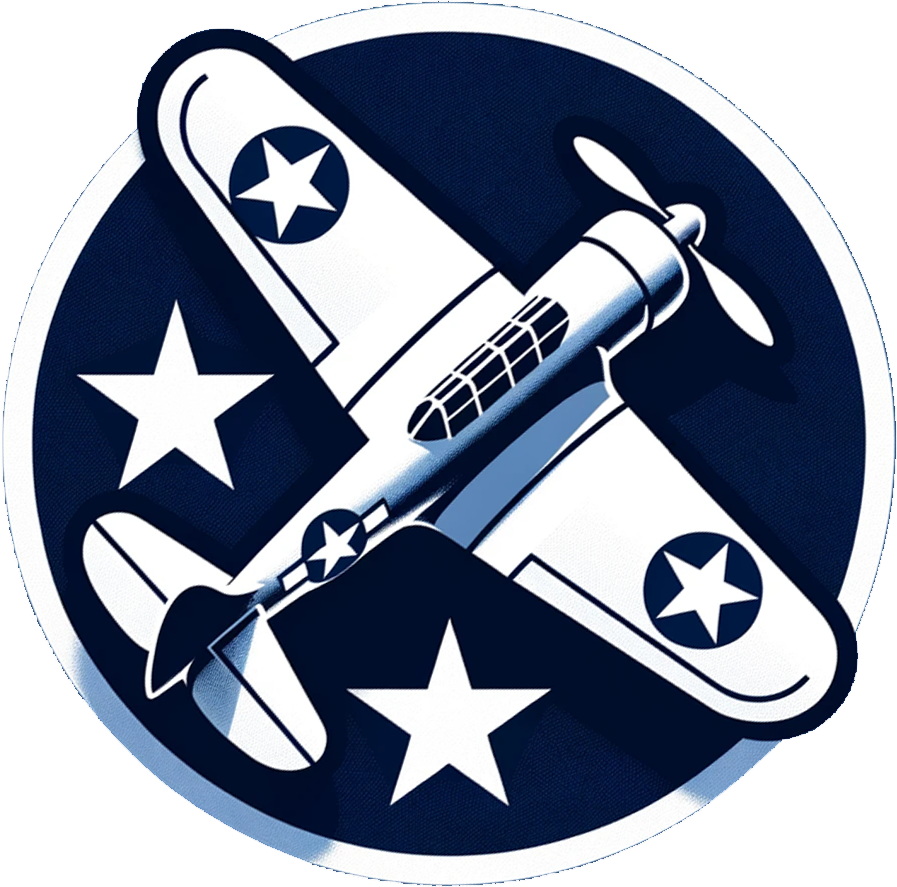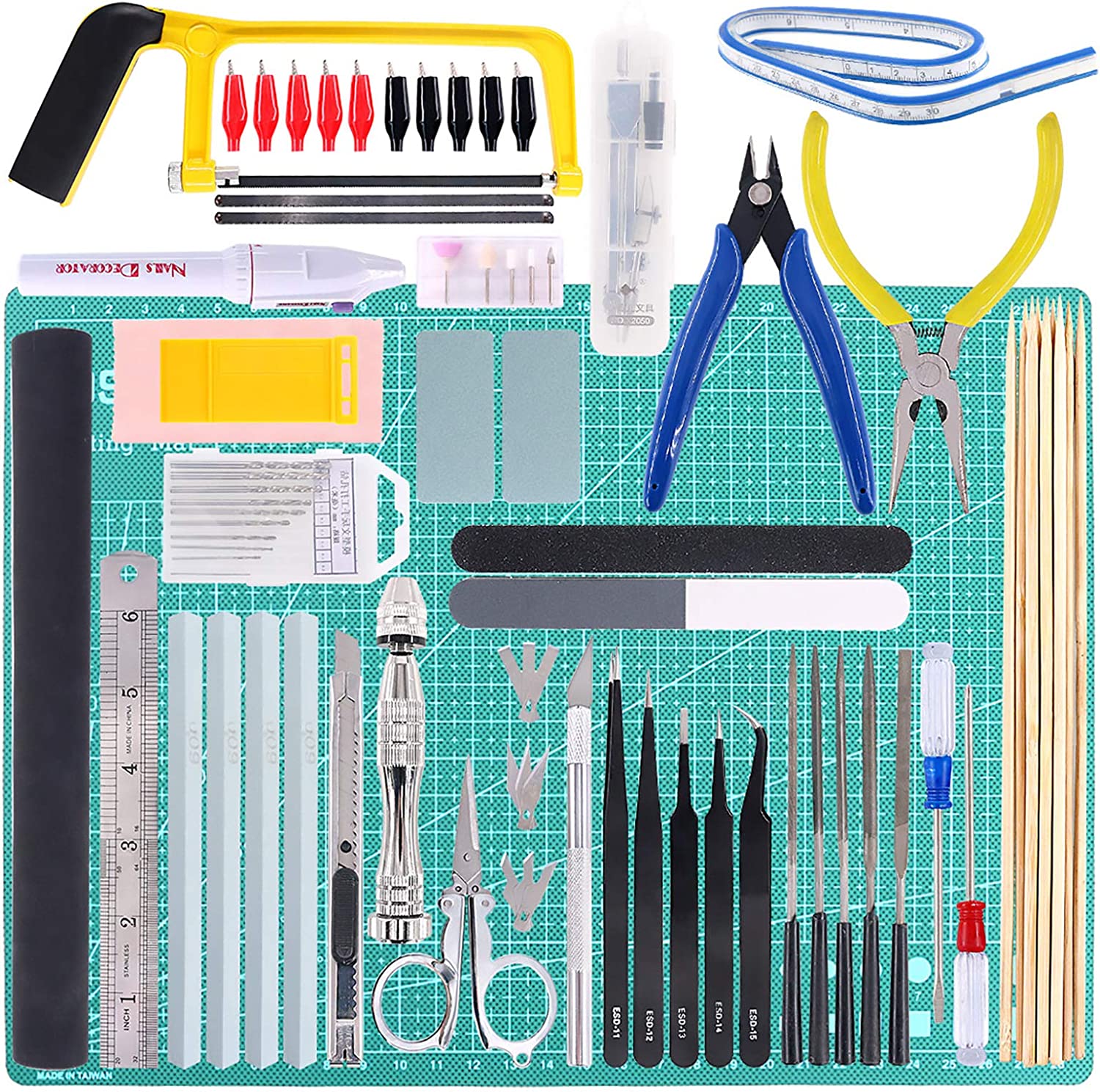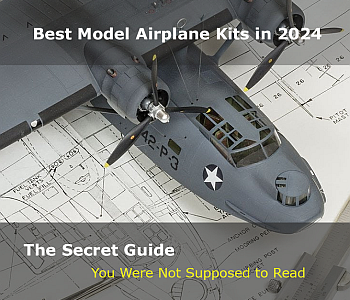A corner of a table, a few simple but well-chosen tools, and a bottle of glue are more than enough to build plastic model kits. With plastic, there’s no dust flying around the room, and there’s no need for exotic paints. Besides, at least in the beginning, there’s no need for specific knowledge or sophisticated tools.
It’s a win for both parents and beginner model builders! Let’s take a brief look at setting up the workspace. The support surface, which will serve as a workbench, can be a piece of cardboard at least fifty centimeters on each side. A newspaper, a sheet of plastic, or even a piece of linoleum will provide ample protection against glue or paint spills. When cutting is necessary, use a small wooden block to protect both the cardboard (which can be reused) and the table.
Next to the cardboard, have a small tray (an empty box works well) to store tools when not in use.
The basic equipment:
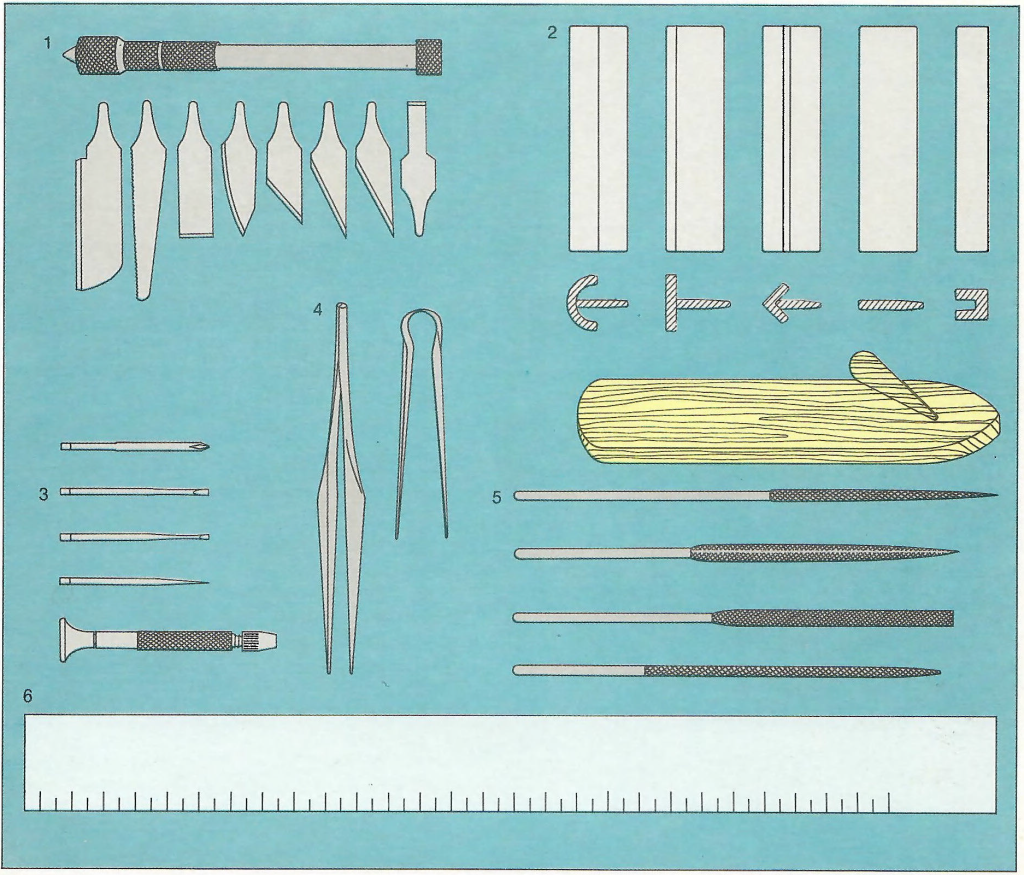
The basic equipment is simple and relatively inexpensive. However, buying good-quality tools is always better, as the few extra dollars are usually worth it.
- A lightweight hobby knife (commonly called X-ACTO). It should have replaceable blades and be lightweight. You can find them in various weights, sizes, and prices at specialized stores. Among the blades, the straight-edged one is best for cutting plastic and will also be useful for detaching parts from the kits. Keep a close eye on the condition of the blades, as they need to be sharper for more delicate tasks to prevent plastic deformations.
Alternatively, you can use those small snap-off blade knives found in any stationery store for a few dollars. When a blade is worn, snap it off to advance the next, very sharp blade.
It’s always a good idea to have a few spare blades on hand. In case of a complete breakdown, you can also use razor blades, although they are more difficult to handle due to their double edge.
- The best files for the job are metal ones, between 15 and 20 cm long, available in flat, round, and triangular sections; square or oval models can also be useful. The grit should be fine, allowing for gentle work. Files of this type can be quite expensive, especially if they are made of steel, but they are a solid investment since they last a long time and enable precision work. To clean them, purchase a small metal brush, similar to those used for suede shoes, which helps remove plastic debris that tends to stick to the grit.
- Sandpaper holder: In its simplest form, it’s a small wooden block around which you attach sandpaper to smooth joints and irregularities, correct profiles, and calibrate parts. You can buy a complete set of three or four sandpaper holder handles in most model shops, but their usefulness for plastic modeling can be hit or miss. In this field, it’s best to use lightweight tools, 3 to 4 cm wide and 8 to 10 cm long, which are too simple to justify industrial-scale production. Therefore, use a wooden block around which you wrap extra-fine sandpaper; do not attach or glue the paper, as holding it with your fingers allows you to adjust its tension and better “feel” the work. This system also lets you quickly move the worn part of the sandpaper. We said sandpaper instead of sanding paper because the latter tends to scratch plastic; although it can be used for rough tasks (reducing a wing’s section, for example), it is not suitable for more delicate work. Sandpaper, on the other hand, allows for very fine work and is available in much finer grits than sanding paper. Sandpaper is more effective than it appears, so be gentle when using it. For even smoother surfaces, you can use abrasive paste, sold at paint stores. Spread the paste with a finger and, once dry, remove it with a cloth, preferably wool. This process restores the shine to surfaces that have become opaque after being sanded; the paste is quite greasy, so thoroughly wash the plastic before painting.
- Screwdrivers should have interchangeable tips, with shafts measuring around 5-6 cm in length; a spinning handle can often make the job easier. A screwdriver of this kind, which can be found at hardware stores, is also useful for making small holes; all you need to do is attach a drill bit to the handle. For smaller holes, it’s actually better to do the job by hand, as this allows you to more easily control the force and prevent the plastic from melting due to friction caused by an electric drill’s head.
- Pliers can be of any type, and the ones typically found among toiletry items work just fine. You’ll need at least two types: one with long, straight jaws and another with bent jaws. If you wish to further expand your toolkit, you can purchase reverse-action tweezers, which help hold a piece in place while keeping both hands free. Another essential yet inconspicuous item for a modeler is a flat metal ruler with measurement markings. Its primary use will be to guide cutting operations, so it should be both extremely rigid and very straight; for this reason, it’s best to purchase a specific one rather than relying on wooden or plastic rulers sold to students.
The tools listed above make up the basic kit, the absolute minimum, and should be specifically purchased for model building.

All other tools can usually be found around the house:
- Scissors: To maintain household peace, it’s better to buy a pair dedicated solely to model building; the type with straight, long blades is perfectly suited for this purpose.
- Cardboard nail files can sometimes replace abrasive-handle grips.
- A backsaw is helpful for correcting glaring mistakes and cutting curved surfaces; in this case, you should cut about 1 mm away from the desired line, allowing for the cut to be finished with a file or sandpaper.
- Lacking a highly sophisticated drilling system, you’ll need to have a few drilling tips or a hand drill equipped with ultra-fast tips, which allow for quick drilling without heating the plastic, resulting in clean and burr-free holes.
- Clothespins: Extremely useful, these clips help keep glued parts under pressure or provide a safer way to handle pieces while painting. For example, a tire can be easily painted by placing it on a pin and then holding it with a clothespin, allowing both sides to be painted in one go.
- A dropper, even one from an empty medicine bottle, allows you to measure paint accurately and create special new shades that can be easily recreated later.
- Wire can be used to apply glue to delicate areas or serve as a realistic structure or thickness.
- Needles, which have the same use as wire, are also helpful for handling very small pieces.
- A compass can be used to measure parts to ensure scale accuracy, mark sheet metal cutting lines, or indicate where holes should be drilled later.
- Toothpicks can be used to spread glue or handle tiny parts.
- Lastly, rubber bands help hold two pieces together that have just been glued or correct the shape of parts that have been warped by heat. They can even be used before gluing during dry assembly to ensure a perfect fit between two parts (fuselage halves, upper and lower wing surfaces, etc.).
More sophisticated equipment
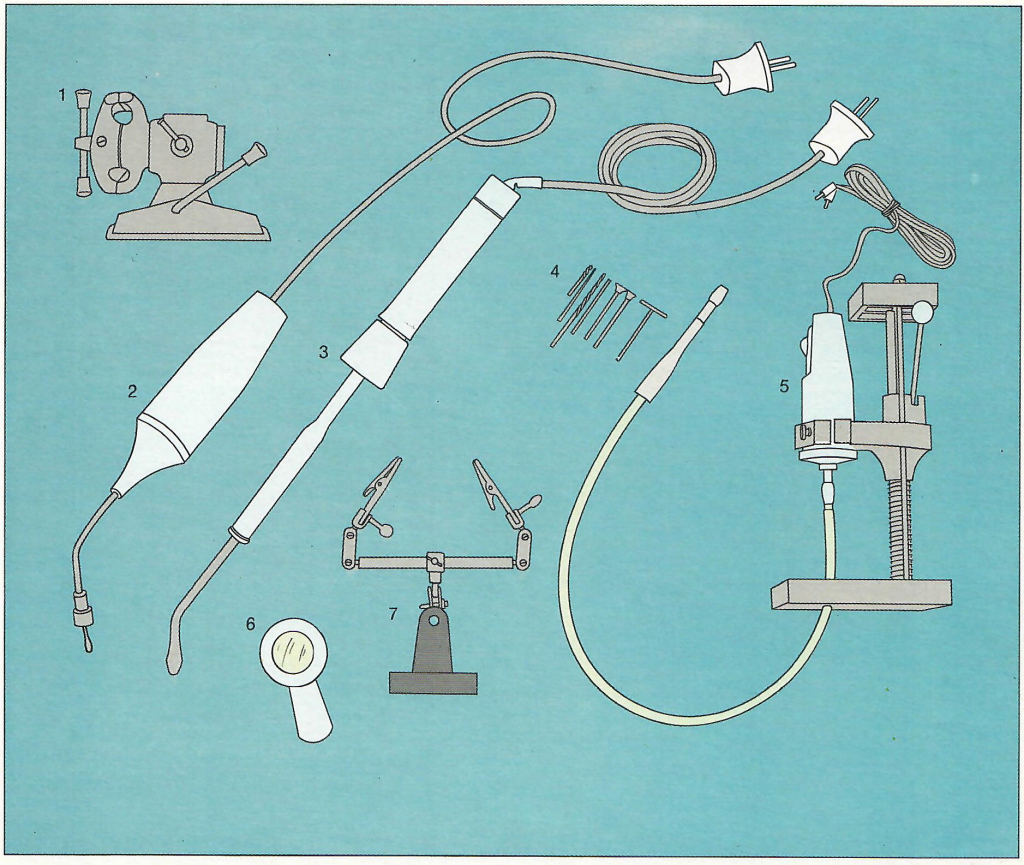
In addition to these basic tools, which don’t require significant spending, the experienced modeler will likely want to add equipment that, as their expertise grows, will allow them to carry out their hobby more efficiently.
- Small suction vise: This vise can be mounted on any smooth surface without nails or screws, and it leaves no permanent marks. Its very nature of attachment allows for use only in light tasks, such as holding parts in place for painting or securing them during challenging gluing. These vises usually have 3 to 5 cm long jaws, which are more than enough for model building. Before closing the jaws, it’s recommended to place a piece of cardboard, light wood, or paper between them and the plastic part to avoid damage or breakage of the piece being worked on.
- X-tra hands: This tool consists of a heavy steel base with one or two arms equipped with crocodile clips mounted on ball joints. As its name suggests, it’s useful for holding thin parts while working on them.
- Versatile electric tool: Essentially, this is an electric motor fitted with various accessories and can be used as a drill, a grooving tool, or a milling machine. Mounted on a stand and able to run on batteries or mains power, this tool enables many specialized tasks. However, its price may not justify the purchase if it won’t be used frequently.
- There are many electric soldering systems available on the market; if you want to have on in your toolbox too, it’s better to purchase a small model, as it will only be used for very minor tasks, such as attaching wheels to landing gears. However, you can do without it by using any blade (an old knife or screwdriver) that has been preheated over a small flame.
- If you’re truly committed to the realism of the finished model, it’s recommended to buy a magnifying glass, preferably mounted on a stand, in order to accurately paint all the markings and symbols found on modern aircraft.
- Mini-torch for plastic: This tool can revolutionize the art of building plastic models, as it allows for thermo-welding to replace gluing operations. In fact, you simply run the hot tip over the plastic, which melts just enough to enable sufficient welding. You can weld significant parts, such as wings or fuselages, but welding smaller pieces is notably more complicated than gluing them.
- “Dentist’s instruments”: Mainly, these are tools that end with very fine points or hooks, which can be used by modelers to engrave extremely fine details (pilot’s face, riveting, etc.) or to position very small parts (engine details or cockpit elements of large-scale models, for example). However, their high price doesn’t justify their presence in every modeler’s workshop.
Materials
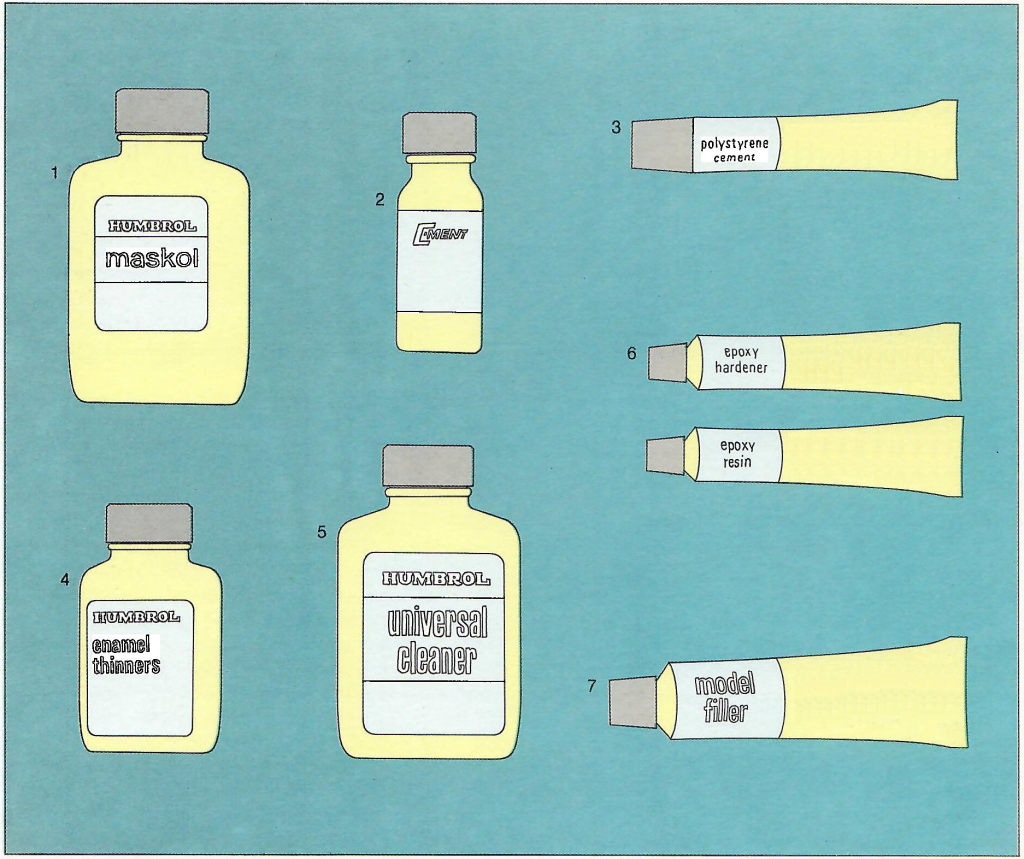
Besides their tools, model builders should always have a few handy accessories nearby.
- Clear adhesive tape: It’s essential; its uses are virtually endless, ranging from masking surfaces to be painted in different colors to temporarily holding parts in place while they dry.
- Tissue paper: Useful for cleaning brushes, fingers, models, the workspace, removing water from decals, and more.
- Body putty: Great for temporarily attaching parts during painting, securing weights in the nose of aircraft with tricycle landing gear, or reshaping poorly profiled pieces.
- Small lead weights: Whether for fishing or hunting, they are indispensable for creating balancing weights.
- Fillers: Various types are available, typically well-suited for correcting imperfections or hiding poorly sealed glue joints. Apply in thin, successive layers, allowing them to dry before smoothing them with sandpaper.

